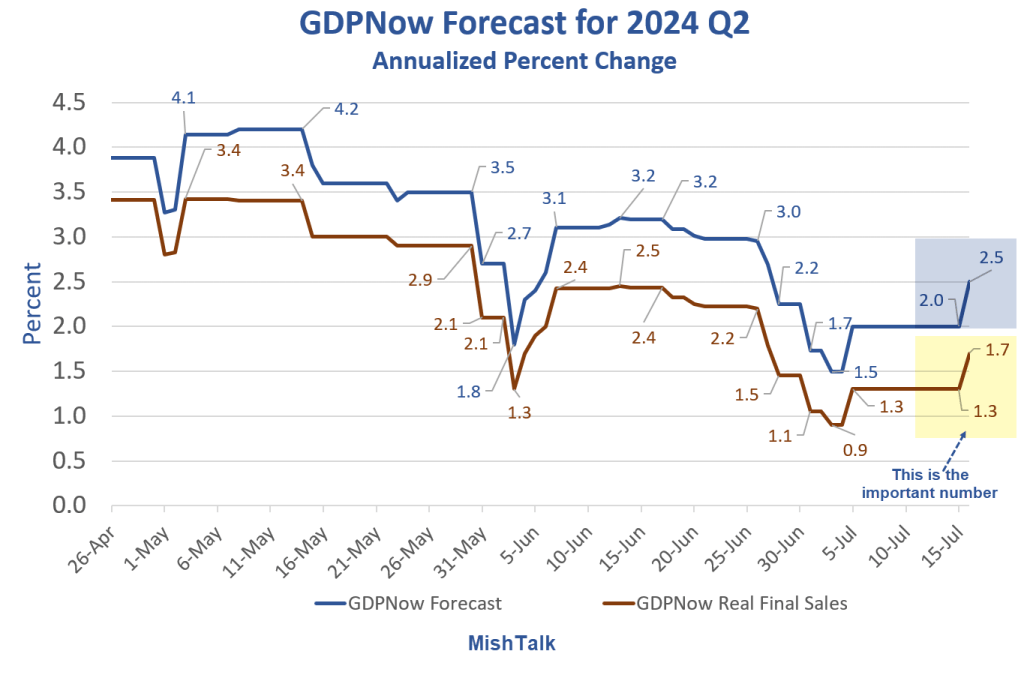The GDPNow nowcast jumped from 2.0 percent to 2.5 percent on stronger than expected retail sales.

GDPNow Chart Notes
- The base forecast, and the one most observers watch but shouldn’t, is the blue line above.
- Real final sales is the bottom line estimate of the economy.
- The difference between the two lines is Change In Private Inventories (CIPI) which nets to zero over time.
- RFS is not always below the base forecast. That just happens to be the case this quarter.
The July 16 GDPNow Model estimates a nowcast of 2.5 percent.
The GDPNow model estimate for real GDP growth (seasonally adjusted annual rate) in the second quarter of 2024 is 2.5 percent on July 16, up from 2.0 percent on July 10. After this morning’s retail sales report, the nowcast of second-quarter real personal consumption expenditures growth increased from 1.6 percent to 2.1 percent.
A nowcast is the current running estimate that tends to be more accurate over time. It’s not a forecast of events.
My first instinct as posted on Twitter was for a net bounce due to “better than expected” retail sales. But the details seems so weak, especially auto sales that I did have a strong position on how the model would react.
Understanding GDPNow Reactions
“Better than expected” means better than the model expected not better than economists expected. In this case, both were true.
It’s not whether the report was good or bad or better than economists expect that matters.
Instead, to guess the reaction by GDONow to economic data, one needs to guess what the model expected, not the actual report itself. This is why the nowcast sometimes rises on bad data or drops on what appears to be good data,
Today the model was as surprised as the economists by retail sales. In contrast, the model had almost no reaction to seemingly poor trade data. The model expected the trade data.
Contributions to the Nowcast
The contribution to net exports since the last report on July 10 was a minimal change from -0.79 percentage points to -0.74 percentage points, and increase of 0.5 percentage points.
Buying more stuff contributed 0.10 percentage points to PCE goods and eating out added 0.28 percentage points to PCE services, a total of 0.38 percentage points.
Other changes between July 10 and July 16 raised the total net contribution to the base model of 0.5 percentage points and 0.4 percentage to real final sales.
Real Final Sales
The nowcast of real final sales is 1.7 percent up from 1.3 percent. That is the number to watch.
Bond Market and Crude Reaction
Yield on the 30-year long bond fell from 4.45 percent to 4.38 percent.
Yield on the 10-year note fell from 4.23 percent to 4.17 percent.
The price of West Texas Intermediate crude fell by $1.03 to $79.82.
Neither the bond market nor energy market seems to believe this report, and I am not sure I do either.
Retail Sales Stronger than Expected, But Look at the Details
For more on retail sales please see Retail Sales Stronger than Expected, But Look at the Details
Nonstore sales (think Amazon) were up 1.9 percent from a month ago. Motor vehicles and parts fell 2.0 percent. This behavior has been ongoing since April of 2022.
Also see Fed Chair Jerome Powell’s warning to Congress: The US Really Needs to Fix the Unsustainable Deficit